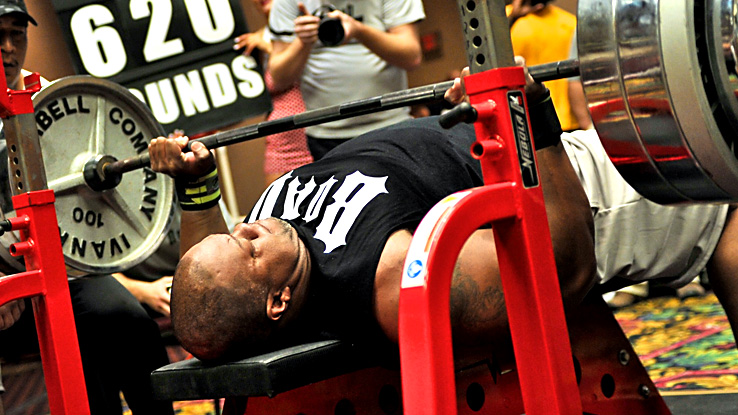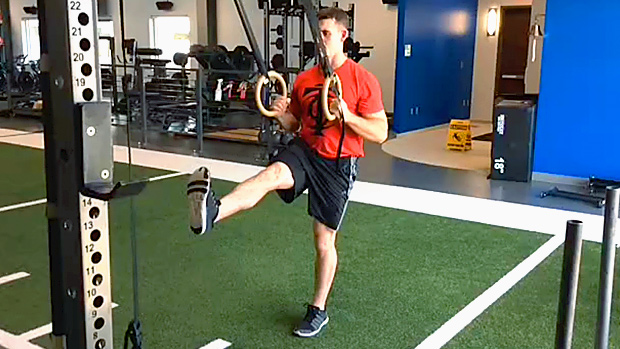The Truth is Out There
Have you ever noticed that muscular growth isn't a linear process? In other words, growth doesn't come at a continuously steady pace. If it did, you'd be able to measure progress by the month or even by the week. For example, if 12 pounds of muscle were to be gained in one training year, you could expect one pound per month. And if you did everything correctly (i.e. consume enough protein, overfeed by the correct amount of calories, etc.) you should even be able to measure the weekly increases of one-fourth of a pound. Wouldn't that be nice?
But weight gain and muscular growth don't happen that way. Not in infants, toddlers, teenagers, or even weight trainers. Instead, weight gain seems to come in spurts or surges. It's amazing how you can train hard and eat very well year round yet only seem to make progress in quick little infrequent spurts of growth. During the major portion of the year, you just plod along for weeks or months on end. Then, just before you throw in the towel to take up chess or ping pong – bang! – three pounds of new muscle in two weeks.
But how does this happen? What triggers this surge in growth?
Ideally we could turn to science for the answer, but in this case there's no good research to point us in the right direction. In fact, we're more likely to find some answers if we put agents Scully and Muelder on the task. After all, this mysterious growth spurt phenomenon seems to be more along the lines of an X-Files episode. But never fear, the truth is out there.
In speculating as to the reason for the ever-illusive growth spurt, we've come up with a number of potential causes. These factors can be related to food intake, training alterations, supplementation, work and personal stressors, and a dozen more. And to further complicate the matter, it's probably some strange interaction between these factors, rather than any one or two alone, which allows for the surge in growth. To put it in a relatively non-scientific way, the cosmic forces seem to align in just the right way to increase your muscle mass.
As the above discussion implies, most people fall into this stage of muscular growth almost by accident. When the cosmic forces align and Aquarius moves into the shadow of the North Star or something, if you just so happen to be doing everything else right (training, nutrition supplementation), the big surge hits!
One important thing to keep in mind is that you've gotta be ready when the growth surge hits. You must keep strict with your training, nutrition, and supplementation despite the inevitable periods of growth draught. And then when the growth spurt happens, everything will be in place to explode!
So, standing firmly atop our soapbox, this is where we preach year-round focus and discipline. In our opinion, if you can't keep focused and dedicated, you don't deserve to grow.
The Trigger
As mentioned above, the growth spurts that most trainees experience are still a mystery. And as a result, those on the quest for muscle growth can become lost in the muscle maze, wandering around aimlessly with no direction or focus. But what if we told you that we're on track to discovering the map to this maze, that we're on track to figuring out how to prime your body for one of those amazing surges in muscle and strength gains? What if we told you that with the right training and diet, you could not only get ready for a size surge, you could actually trigger it on your own?!
Have we figured out how to accomplish this yet? Have we found the key to unlock the doors to new growth? The answer is... maybe. What we've done is put together a complete program that will prime your body for two weeks of intense training and eating. (What's that? You think eating can't be intense? Just wait to see what we have planned for you!)
The program involves weight training, diet, and supplementation. It's labor intensive and it's tough both physically and mentally, especially during stage two. But if you can make it through the program, you'll bust through any growth plateau you may be struggling with. You will get bigger and stronger.
So, why did we say "maybe" to the questions above? Well, because although this program makes perfect sense and is based on scientific facts, it hasn't been rigorously tested yet. Sure, we played around with the program ourselves and can almost guarantee that you'll see great results, but to truly know if this program is as amazing as we speculate, we need data on a lot of subjects. In science we don't accept the results of one or two people to be representative of a whole population of subjects. However, when a couple dozen subjects see similar results, then we have some evidence.
So that's the purpose of this article. We want to launch the great Growth Surge Project. Part of what we love about bodybuilding is experimenting with new training and diet protocols, tweaking them, modifying them and coming up with something really cool that we can share with others. So here's our plan. Instead of reporting on what happened with just the two of us, we'd like to get as many objective T-mag readers as we can to try the program. At the bottom of the final article in this series, we'll provide a link to a feedback form. After you finish the program, fill out the form, and tell us about your results.
Here's how it works:
We'll give you the complete program and lay everything out for you. All you have to do is follow the program to a "T" and give us your feedback by filling out the form. After the project is over, we'll gather the data and post the results, and then make any necessary adjustments to the program to make it more effective. We thought about offering some sort of prize for those that participated, but hey, the fun of discovery, along with the potential of adding a significant amount of lean mass should be enough, right?
Now let's cut to the chase and take a closer look at the training, diet and supplementation that could push you up to or even through the next level!
The Growth Surge Project: Overview
There are three main stages to this program: Priming, Growth Surge, and Recovery.
The Priming Stage – This will last two weeks. In this stage you'll be preparing your body for a period of intensive training by helping to resolve any overtraining issues or issues of poor nutrition.
The Growth Surge – This will also last two weeks. During this time, most of you will train twice per day and pay meticulous attention to your diet and supplementation protocols. (Note: For those that just can't fit in two workouts a day, we'll provide an alternative plan.)
The Recovery Stage – This final phase will help you bounce back from your intensive two-week program by facilitating recovery and fine tuning your diet.
The entire program will take six weeks. If we're correct, you can expect to put on anywhere from 5, 10, maybe even more pounds of weight (possibly a lot more as MAG-10 becomes available for the Growth Stage), most of it being lean body mass.
Now, let's dive right into the first stage.
The Priming Stage
During the two weeks we call the Priming Stage, we need to clean up your diet so that you're ready for the Growth Surge eating and training programs. The diet portion of this priming stage entails following the Massive Eating meal combination patterns, but eating a diet that's slightly hypocaloric. To do this, use the "Don't Diet" calorie formula (provided at the end of this article) and the food recommendations listed in the "Appetite for Construction" article.
Note: For those of you not familiar with Massive Eating, this is an eating plan that involves eating protein with every meal, but never mixing carbs and fats in the same meal. The "Don't Diet" version is simply a lower calorie, fat loss version of Massive Eating.
For example, in one meal you may have cottage cheese, some protein powder, a piece of fruit and a cup of oatmeal. That's a "P + C meal," protein plus carbs with very little fat. (You may have some fat, but keep in under 10 grams in P + C meals.)
In another meal you may have a can of tuna, a salad, mixed nuts and two yummy teaspoons of flax oil. That's a "P + F" meal, protein plus fat with very few carbs. (Again, just keep the carbs under 10 grams in P + F meals.)
Some may ask us why we don't just choose a ketogenic diet for this time frame. Well, we have two very important reasons. First, after a ketogenic diet your body will be primed for fat gain, not muscle gain. And when you see how many calories you'll be eating in the next stage, you'll see why we don't want the body primed for fat gain!
Second, after following a ketogenic diet your body will also be primed for massive water gain. It's easy to put on 10 to 15 pounds of water in two weeks of normal eating after a ketogenic diet. Since we want this program to yield true muscle gains and not just short-lived water gains, we're going to avoid the bloat.
But doesn't the "bloat" stimulate muscle gain by stretching muscle cells or something? In some cases it may. But in the case of this program, trust us when we say that the growth will be taken care of!
Also during this priming stage, we need to get you well rested so that your Growth Surge phase will yield the biggest results. You can't experience a growth spurt if you're coming into it overtrained. So during this time period, you'll be training only three days per week.
So, with the theory laid out, here's the program for the two week Priming Stage:
Nutrition
Using the Don't Diet calorie formula found at the end of this article, figure out the amount of daily calories you need. In a previous Appetite For Construction column, a sample diet is offered. Make minor adjustments to this program to achieve your required calorie intake. Remember, it's only two weeks, so stay strong. The more disciplined you are during this phase, the better the results during the next phase. No cheat days or "free meals."
Training
During these two weeks, your training volume and intensity will be low. We suggest 12 to 15 total sets per workout during this phase. In addition, we recommend rep ranges in the 10 to 12 range. Don't go to absolute failure during the Priming Stage. Your last rep should be tough but you'll want to stop when you still have a rep or two "in the hole."
You'll be training three days per week using an alternating upper body and lower body program. This means you'll be training six total times during these two weeks. Here's what it'll look like:
Week #1:
Day 1: Upper Body + 20 minutes of cardio
Day 2: Off
Day 3: Lower Body + 20 minutes of cardio
Day 4: Off
Day 5: Upper Body + 20 minutes of cardio
Days 6 and 7: Off
Week #2:
Day 8: Lower Body + 20 minutes of cardio
Day 9: Off
Day 10: Upper Body + 20 minutes of cardio
Day 11: Off
Day 12: Lower Body + 20 minutes of cardio
Days 13 and 14: Off
We recommend using mostly basic compound movements in this stage. Here's a sample program:
Upper Body Day
Chest: Bench Press, 3 x 10-12
Back: Bent over Barbell Rows, 2 x 10-12
Wide Grip Pull-ups or Pulldowns, 2 x 10-12
Shoulders: Overhead Dumbbell Press, 2 x 10-12
Biceps: Standing Barbell Curl, 2 x 10-12
Triceps: Skull crushers (tricep extensions), 2 x 10-12
Total – 13 sets
Lower Body Day
Quads: Squats, 4 x 10-12
Hamstrings: Lying hamstring curl, 2 x 10-12
Stiff leg deadlift, 2 x 10-12
Calves: Standing calf raise, 2 x 10-12
Sitting Calf raise, 2 x 10-12
Total – 12 sets
Supplementation
During this phase, you should be supplementing with:
1) Multi-Vitamin/Multi-Mineral
2) 10 grams of regular ol' creatine powder per day (5 grams in each of your Surge beverages on training days or 5 grams dissolved in each of two cups of green tea or other warm beverage on non-training days.)
3) Flax oil – 2 tablespoons per day (taken with your protein plus fat meals)
4) Fish oil capsules – 6 to 10 grams of EPA/DHA per day (This is usually around 15 caps per day depending on the brand used.)
5) Biotest Surge – half a serving sipped during training and half a serving after training
After two weeks you'll be rested and rarin' to go. But what's more, you'll be primed for optimal growth and ready to hit stage two hard. And trust us, the next couple of weeks are going to be hard!
Tips
• Be sure to weigh yourself and measure bodyfat before you start the program. In fact, you'll need to bust out the tape measure and gets some arm, torso, and legs measurements, too. You should take all measurements before each stage of the program so you can watch how it's working. Once the six weeks are over, take final measurements.
• To accurately keep up with how many calories you're consuming, it would be wise, no, make that absolutely necessary, to use a food log of some sort. For info on how to set one up, read our "Missing Ingredient" article.
• This first stage may seem easy and you'll be tempted to train more often and bump up the volume. Don't! Remember, we're just preparing you for the real growth surge you'll experience in the next two stages. If you overdo it during this stage, you won't get the big surge promised by the last two stages.
Conclusion
So it begins. You have the training program, the diet, and the supplementation guidelines. Everything is laid out for you. But this program, as complete as it is, isn't going to help you a damn bit if you just read it and then go about training and eating the same way you've always been doing.
Think about it like this. Six weeks from now, you can look about the same as you do now or you can adopt this program, focus on it with laser-like intensity, and be more muscular than ever before. How would an extra ten or maybe even fifteen muscular pounds look on your frame? Pretty good, huh?
You have the first stage already. If you're serious about packing on some mass, don't wait until the next two articles. Start now! Those who wait or spend six months "gathering feedback" from others are fooling themselves. It's a form of procrastination. Don't fool yourself. If you really want this, start ASAP with the Priming Stage. We'll post the last two stages over the course of the next couple of weeks.
Are you up for a real growth surge? Then go to work.
Tools
Priming Stage Calorie Calculator – How much are you supposed to eat during the first stage? Just follow the steps below and find out.
Step #1 – First, you need to determine your resting metabolic rate or RMR. Divide your bodyweight by 2.2 to convert it into kilograms. A 180-pound guy weighs 82 kg.
Now take your percent of bodyfat and multiply it by your weight in kilograms to get your fat mass (FM). If our 82 kg guy has 12% bodyfat, then 82 x .12 = 9.84 kg FM.
Now subtract this number from your total weight in kilograms to get your fat free mass. Our guy would subtract 9.84 kg from 82 kg to get a Fat Free Mass (FFM) of 72.16 kg.
Now multiply your FFM times 22 and add 500. That's your RMR. Our guy would multiply 22 x 72.16 to get 1582.52. Add 500 for a total of 2087.52. So his RMR is about 2087 calories per day.
Step #2 – Now we need to determine the costs of daily activity. We do this by multiplying your RMR you got above with one of the numbers below that best represents your daily activity level not counting workouts.
Activity Factors:
1.2-1.3 for Very Light (bed rest)
1.5-1.6 for Light (office work/watching TV)
1.6-1.7 for Moderate (some activity during day)
1.9-2.1 for Heavy (labor type work)
So if our sample guy worked in an office setting, he'd choose 1.5. So 2087 calories (his RMR) times 1.5 = about 3130 calories.
Step #3 – Now go back and look at your RMR number again. Our guy's is 2087. To calculate the thermic effect of food, you should multiply your RMR times 0.10 if you eat one gram of protein per pound of bodyweight and 0.15 if you eat over one gram of protein per pound of bodyweight. So 2087 x 0.15 = 313. Our guy would then add that number to his total. 313 + 3130 = 3443 calories.
Step #4 – Now take 85% of this number. You do this by multiplying 0.85 times the total you got in step #3. So our guy would multiply 0.85 times 3443 to get 2926 calories. This is how many calories he'll be eating per day during the Priming Stage.




